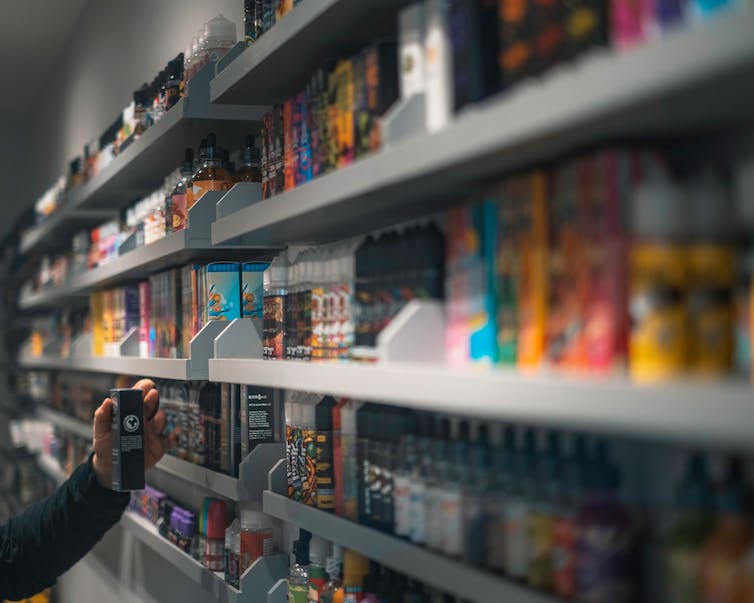We asked over 700 teens where they bought their vapes. Here’s what they said

Teen vaping has been in the news, with reports of rapidly increasing use and illegal sales of e-cigarettes.
As a Four Corners documentary on ABC TV earlier this year showed, parents and schools are struggling to manage this swift rise in vaping, with fears children are addicted and harming their health.
In contrast, very limited research about Australian teen vaping has been published, until today.
We have published in the Australian and New Zealand Journal of Public Health the first results from the Generation Vape study. The study aims to to track teenagers’ knowledge, attitudes, beliefs and behaviours about using vapes (e-cigarettes).
Here’s what we found about where teenagers were accessing vapes and what types of products they use.
À lire aussi :
A damning review of e-cigarettes shows vaping leads to smoking, the opposite of what supporters claim
Vaping common, especially in non-smokers
We surveyed more than 700 teenagers 14-17 years old from New South Wales. The sample was closely representative of the population, with key characteristics such as age, gender, location and education monitored throughout data collection.
We found teenagers are readily accessing and using illegal, flavoured, disposable vaping products that contain nicotine.
Among the teens surveyed, 32% had ever vaped, at least a few puffs. Of these, more than half (54%) had never previously smoked.
À lire aussi :
A parent’s guide to why teens make bad decisions
Where are teens getting vapes from?
We found most teens (70%) didn’t directly buy the last vape they used. The vast majority (80%) of these got it from their friends.
However, for the 30% who did buy their own vape, close to half (49%) bought it from a friend or another individual, and 31% bought it from a retailer such as a petrol station, tobacconist or convenience store.
Teens also said they bought vapes through social media, at vape stores and via websites.
À lire aussi :
How can we reverse the vaping crisis among young Australians? Enforce the rules
What products are teens using, and why?
Of the teens who had ever vaped and reported the type of device they used, 86% had used a disposable vape. This confirms anecdotal reports.
These devices appeal to young people and are easy to use. They do not require refilling (unlike tank-style vaping products) and are activated by inhaling on the mouthpiece.
Disposable vapes can contain hundreds, or even thousands of puffs, and are inexpensive, with illicit vapes from retail stores costing between $20-$30, or as little as $5 online.
This ‘Juicy Fruity’ disposable vape resembles Juicy Fruit chewing gum.
Author provided
There is an enormous range of vape flavours likely to appeal to children – from chewing gum to fruit and soft drink, even desserts. So it is unsurprising teens rated “flavourings and taste” as the most important characteristic of vapes they used.
Disposable vapes often contain very high concentrations of nicotine, even those claiming to be nicotine-free. The way these products are made (using nicotine salts rather than the free-base nicotine you’d find in cigarettes) allows manufacturers to increase the nicotine concentration without causing throat irritation.
In our study, over half (53%) of the teens who had ever vaped said they had used a vape containing nicotine. Many, however, were unsure whether they had used a vape containing nicotine (27%).
All vaping products, irrespective of nicotine content, are illegal to sell to under 18s in Australia.
Today, disposable vapes containing nicotine can only be legally sold in Australia by pharmacies to adult users with a valid prescription.
À lire aussi :
Many e-cigarette vaping liquids contain toxic chemicals: new Australian research
We need to end illegal imports and sales
Our results emphasise that teen vaping is increasingly normalised, and the most popular devices are designed to be highly appealing to young people. This is despite product manufacturers and proponents claiming they are smoking cessation aids only for adult smokers who are struggling to quit.
Turning the tide on teen vaping requires strong and immediate policy action, including ending the illicit importation and sale of vaping products.

We need to clamp down on the illegal sale of e-cigarettes.
E-Liquids UK/Unsplash, CC BY-SA
Education is often the default first action to address unhealthy behaviours in young people. However, unless this is coupled with strong, supportive policy action, this approach is unlikely to have any measurable impact. Education campaigns cannot protect young people from an industry that so freely disregards laws meant to protect health.
We have strong evidence that vaping leads to harms such as poisoning, injuries, burns, toxicity, addiction and lung injury. The odds of becoming a smoker is more than three times higher for never-smokers who vape than for never-smokers who don’t vape.
À lire aussi :
Making it harder to import e-cigarettes is good news for our health, especially young people’s
What’s next?
This study uses data from the first wave of the Generation Vape research project, a three-year study with Australian teenagers, young adults, parents and guardians of teenagers, and secondary school teachers.
It is funded by the Cancer Council NSW, federal Department of Health and Ageing, NSW Ministry of Health, Cancer Institute NSW and the Minderoo Foundation.
Future waves of this repeat cross-sectional study, coupled with in-depth interviews, will allow us to track and monitor changes to adolescent, young adult, teacher, and parent attitudes, perceptions, and knowledge of vaping over time.
Vaping is a rapidly evolving public health crisis in Australia. Our research provides evidence for concerted policy action to prevent young people from accessing harmful and addictive products.
Failure to act will see a whole new generation of Australians addicted to dangerous products.






